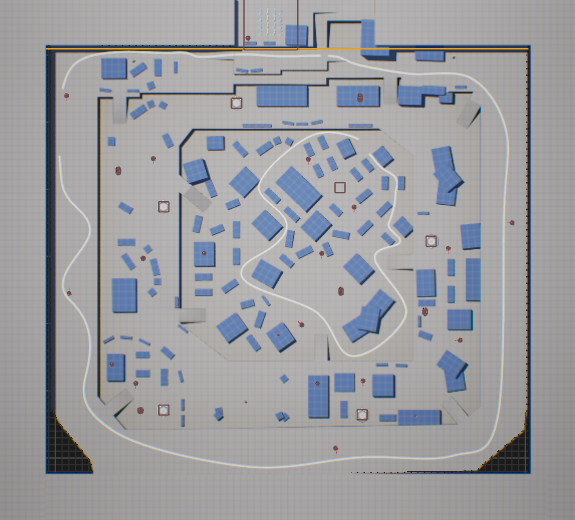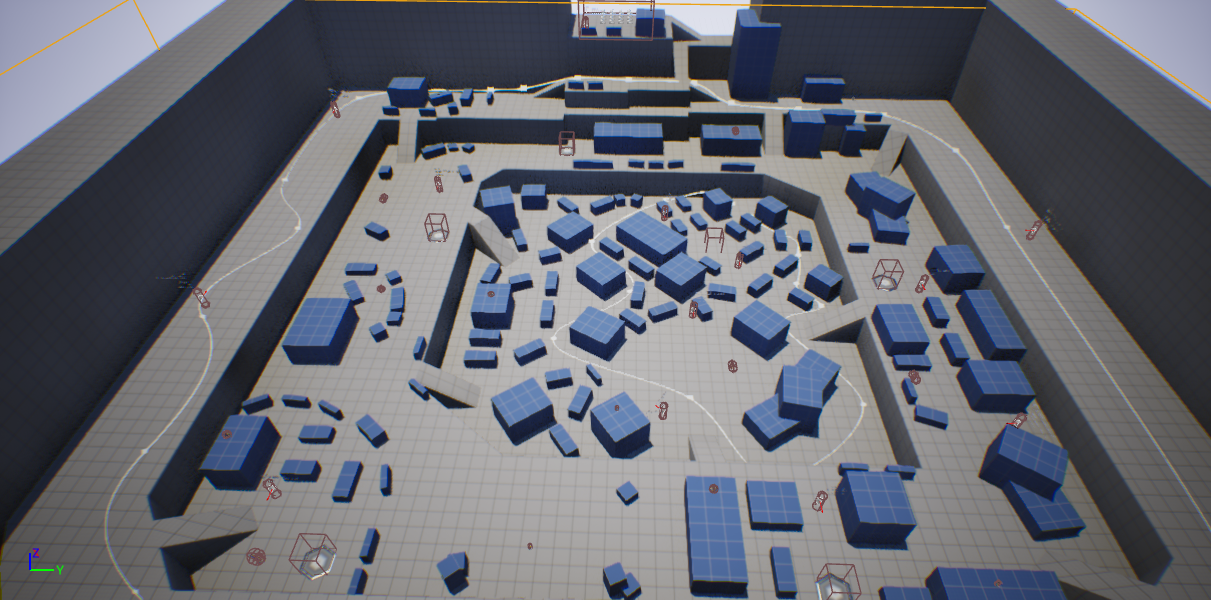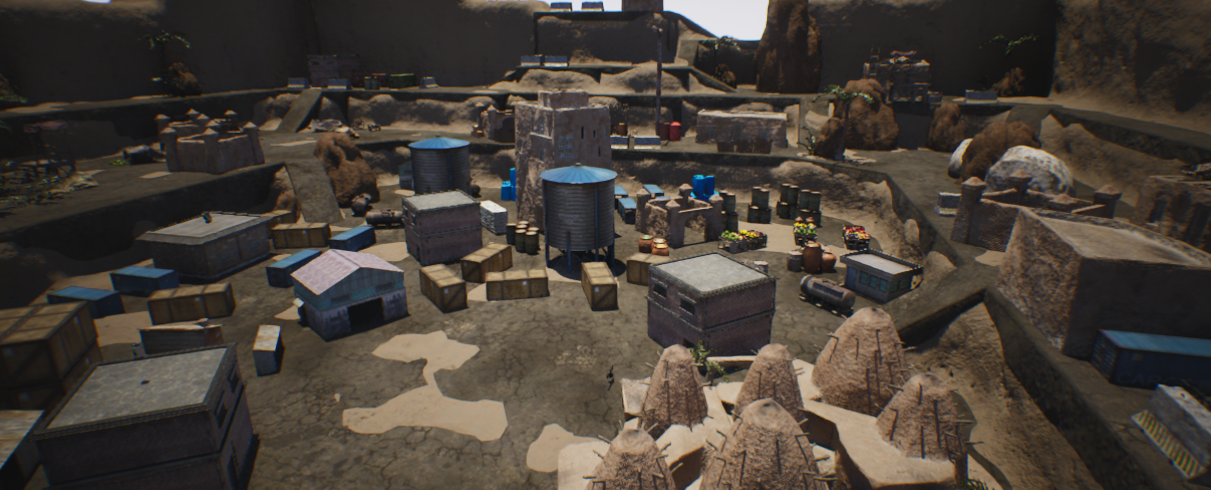Unreal Engine Top Down Shooter
Welcome to my top-down shooter prototype, a project that embodies my passion for game design and my commitment to creating balanced, engaging gameplay experiences. This prototype highlights my ability to craft intricate class-based mechanics, where players must strategically leverage the unique strengths of each character to succeed.
In this game, I've focused on developing distinct roles—Tanks, DPS, and Support—that interact in meaningful ways, ensuring that each class brings something vital to the battlefield. Through careful balancing and iterative testing, I've created a dynamic environment where teamwork, quick thinking, and tactical precision are essential. This project showcases my skills in game design, systems balancing, and my dedication to delivering compelling and competitive gameplay experiences.
- CLIENT ONE BUTTON SOLUTION LLC
- YEAR 2024
- CATEGORY GAME DESIGN, LEVEL DESIGN, ENCOUNTER DESIGN, COMBAT DESIGN
CHARACTER AND ENCOUNTER DESIGN
The character and encounter design in this prototype reflect a deep commitment to creating a balanced and engaging gameplay experience. Each class is thoughtfully designed to fulfill a specific role, contributing to the team’s overall success. Encounters are crafted to challenge players to think strategically and work together, ensuring that the game remains dynamic and rewarding. This design philosophy highlights my ability to create intricate, balanced systems that enhance player engagement and promote strategic depth.

Character Classes
Drawing from the foundational principles discussed in this project, I have created a diverse set of character classes, each with unique attributes and combat roles. These classes are designed to complement and counterbalance each other, ensuring dynamic interactions and strategic depth in every encounter.Each character class is designed with specific strengths, weaknesses, and tactical roles in mind:
The Assault class is the frontline powerhouse, equipped with high health and a Combat Shotgun that delivers devastating damage in close quarters. This class is designed to absorb damage and lead the charge, making it essential in pushing through enemy defenses. The trade-off is its limited range and moderate mobility, which makes it vulnerable to long-range attacks.
The Brawler class is the toughest of all, wielding a high-damage Melee weapon and boasting the highest health in the game. This class excels in close combat, where its high damage and durability can overpower opponents. However, its lack of ranged attacks and lower mobility make it reliant on strategic positioning and support from teammates to close the distance to enemies.
Designed for high mobility and tactical flexibility, the Infiltrator class uses an Assault Rifle that offers a balance between fire rate and damage. With the ability to engage quickly and retreat just as fast, the Infiltrator is perfect for hit-and-run tactics. However, its lower health and moderate damage output mean it struggles in prolonged engagements against tougher opponents.
The Marksman class is the master of long-range engagements, using a Sniper Rifle to deal significant damage from afar. This class is all about precision, capable of taking down key targets with a few well-placed shots. The trade-off for its high damage and range is its low fire rate and vulnerability in close quarters, requiring careful positioning and strategic play.
The Tactic class supports the team with a Pistol MG, providing sustained fire with a high fire rate. This class excels at harassment and applying consistent pressure on enemies, but its lower damage per shot and limited range make it less effective in direct combat against more robust classes. It relies on its mobility to stay out of harm’s way while assisting teammates.
Equipped with a Grenade Launcher, the Grenadier class excels in area damage and controlling the battlefield. This class can effectively clear groups of enemies or deny areas to opponents, making it a strategic asset in controlling the flow of battle. The trade-offs include a low fire rate and long reload times, making the Grenadier vulnerable if caught out of position or without support.
Encounter Design
Encounters in this prototype are designed to challenge players’ understanding of their class roles and the synergies between them. The core philosophy behind encounter design is to ensure that no single class can dominate on its own; instead, success comes from leveraging the unique strengths of each class while mitigating their weaknesses.
Players are encouraged to think strategically about how they approach each encounter. For instance, Tanks should draw enemy fire and soak up damage while DPS classes deal heavy hits from safer positions. Meanwhile, Support classes must maneuver to assist and harass enemies, creating openings for their teammates.
The design emphasizes interactions where each class has a role to play and counters to consider. For example, a Brawler might need to rely on an Infiltrator’s speed to distract or flank enemies, allowing them to close in for a melee attack. Similarly, a Grenadier can use area denial to protect a Marksman, giving them the space needed to line up critical shots.
Encounters are balanced around the idea that each class has its strengths and counters. A Tank might dominate in close quarters but struggle against a well-positioned Marksman or Grenadier. Conversely, a Support class may excel at controlling space and assisting allies but will need to avoid direct confrontations with Tanks.
Level Design Overview
The level blocking and design for this top-down shooter map are grounded in principles that prioritize replayability, dynamic encounters, and player agency. The combination of a central combat arena surrounded by smaller, tactical mini arenas ensures that the map remains engaging and versatile, catering to a wide range of playstyles and strategies. By adhering to these principles, the map is designed to provide a compelling and varied gameplay experience, ensuring that each match feels fresh and challenging.

Principles Followed in Level Design
My approach to level blocking focused on creating a balanced and engaging environment that supports varied gameplay styles, maximizes replayability, and maintains a high level of player engagement.
To ensure that the map remains engaging over multiple playthroughs, the layout was designed with replayability in mind. The variation in arena design, coupled with the potential for dynamic spawning of objectives or items, ensures that no two matches play out identically. This aligns with the principle that top-down shooter maps should evoke different emotions and scenarios in each playthrough, maintaining player interest and reducing predictability.
The map’s design supports a variety of playstyles. For instance, players who favor close-quarters combat can leverage the tighter, more enclosed mini arenas, while those who prefer ranged engagements can use the open areas of the central arena to their advantage.
Even though the game is a top-down shooter, the level design incorporates elements of verticality and environmental interaction to add depth to gameplay. For example, some areas may feature higher ground or destructible cover, forcing players to adapt their strategies on the fly. This creates a more dynamic combat environment where the map itself becomes an active participant in the gameplay.
The design ensures that players are constantly moving, with no dead zones or overly safe areas. The placement of cover, obstacles, and open spaces is deliberate, guiding players through the map in a way that feels natural yet challenging. The pacing is controlled through the strategic placement of objectives and spawn points, ensuring that the intensity of combat ebbs and flows, preventing any one part of the map from becoming stagnant.
Level Blocking Strategy
My approach to level blocking focused on creating a balanced and engaging environment that supports varied gameplay styles, maximizes replayability, and maintains a high level of player engagement.
The map is structured around a large central arena, which serves as the focal point of intense combat. Surrounding this central area are multiple mini arenas, each designed to offer distinct tactical challenges and opportunities. This layout encourages players to move dynamically across the map, ensuring that combat remains fluid and varied.
The central arena is designed to be a high-risk, high-reward area. It features multiple entry points, allowing for fluid movement and strategic positioning. This arena is where major objectives or power-ups can be placed, drawing players into frequent confrontations. The openness of this area demands quick reflexes and strategic use of cover, making it ideal for large-scale, chaotic battles.
The mini arenas surrounding the central hub are designed to facilitate smaller skirmishes. Each mini arena has unique characteristics—such as varying cover types, line-of-sight blockers, and elevation changes—that cater to different combat styles. These areas are crucial for breaking up the flow of combat, preventing players from camping or dominating the central arena without consequence.
Gameplay Features
MELEE AND RANGED COMBAT
In this prototype, players can fluidly switch between intense close-quarters melee attacks and precise long-range shooting, allowing for a wide array of strategic options. Whether you prefer the raw power of a melee weapon in tight spaces or the precision of ranged attacks from a distance, this game accommodates diverse playstyles. This flexibility ensures that players can adapt to different combat scenarios, making every encounter unique and engaging.
COVER MECHANICS
The environment is an integral part of the combat experience, with a robust cover system that offers both full and half-cover options. Players can strategically use these environmental features to protect themselves from enemy fire, peek out for shots, and execute tactical maneuvers. This system encourages thoughtful positioning, as taking advantage of cover can be the difference between victory and defeat in heated battles.
BALANCED WEAPONRY
Weaponry in the game is meticulously balanced to ensure fairness and strategic depth. Each weapon has been carefully tuned to offer a distinct balance of power, rate of fire, and reload time, allowing players to select their loadouts based on personal preference and tactical needs. This attention to balance ensures that no single weapon dominates the battlefield, promoting a diverse and engaging gameplay experience.
COMPREHENSIVE BALANCING PARAMETERS
To create a fair and challenging gameplay environment, both characters and weapons are balanced across a range of parameters. These include health, speed, damage, and reload times, ensuring that each character class and weapon fits seamlessly into the overall game design. This comprehensive approach to balancing allows for varied but fair encounters, where strategic use of each class's strengths is key to success.


Balancing
Balancing Strategy
The balancing strategy employed in this prototype focuses on maintaining clear and distinct roles for each class while ensuring that no single class or weapon can dominate the battlefield. By carefully tuning parameters such as damage, mobility, and fire rate, the game encourages players to leverage the strengths of their chosen class while being mindful of their inherent weaknesses. This balance creates a dynamic and engaging combat experience, where strategic decisions and team coordination are key to success.
Through iterative testing and refinement, these balancing decisions have been optimized to provide a fair yet challenging gameplay environment, ensuring that each class feels unique and valuable within the broader game context.
Weapon Balancing
In this top-down shooter prototype, each weapon has been meticulously tuned to ensure that its power, rate of fire, reload time, and other parameters are in harmony with its intended role. The goal of weapon balancing is to provide players with a diverse arsenal where every weapon has a distinct purpose and no single weapon can dominate the battlefield.
By carefully adjusting factors such as damage output, fire rate, and loudness, the game encourages players to choose their weapons strategically, aligning their loadouts with their preferred playstyle and the tactical demands of each encounter.In this top-down shooter prototype, each weapon has been meticulously tuned to ensure that its power, rate of fire, reload time, and other parameters are in harmony with its intended role.
The goal of weapon balancing is to provide players with a diverse arsenal where every weapon has a distinct purpose and no single weapon can dominate the battlefield. By carefully adjusting factors such as damage output, fire rate, and loudness, the game encourages players to choose their weapons strategically, aligning their loadouts with their preferred playstyle and the tactical demands of each encounter.
Weapon Parameters
Fire Rate (rpm): The fire rate determines how quickly a weapon can discharge its rounds, directly influencing its combat role. In this game, slower fire rates like the 4 rpm for the Sniper Rifle are balanced with high-damage outputs, allowing these weapons to excel in precision, long-range engagements. In contrast, faster rates, such as 20 rpm for the Assault Rifle, cater to mid-range sustained fire, making them effective for controlling space and applying consistent pressure.
Fire Delay (s): Fire delay is the pause between shots, which balances the power of high-damage weapons. For example, the Sniper Rifle’s longer delay (1.5s) reflects its ability to take down enemies from a distance with powerful, deliberate shots. On the other hand, rapid-fire weapons like the Pistol MG, with a minimal delay of 0.2s, emphasize speed and mobility, allowing players to quickly respond to threats but with less damage per shot.
Burst: Typically set to 1, the burst parameter is designed to keep weapons controlled and precise. This ensures that each shot counts, making players carefully consider their timing and positioning in combat, especially when using weapons that require precision like the Sniper Rifle or the Grenade Launcher.
Max Ammo and Magazine Size: The balance between max ammo and magazine size is crucial for maintaining the pacing of combat. High-capacity weapons like the Assault Rifle, with a max ammo of 120, allow for prolonged engagements, making them ideal for sustained firefights. Conversely, low-capacity but high-impact weapons like the Grenade Launcher, with just 8 rounds, are balanced to prevent excessive area damage without a significant trade-off in reload time.
Reload Time (s): Reload time adds a tactical layer to gameplay, forcing players to plan their engagements. Quick reloads (1.5s for Pistol MG) enable players to stay in the fight longer, making these weapons ideal for support roles. Longer reloads, like the 4 seconds for the Grenade Launcher, balance the weapon’s devastating power by introducing downtime that can leave the player vulnerable if not managed correctly.
Loudness: Loudness reflects the auditory impact of a weapon, affecting stealth and enemy awareness. High-loudness weapons like the Sniper Rifle demand strategic positioning, as their shots can give away the player’s location. In contrast, lower-loudness weapons support a more stealthy approach, allowing players to engage enemies with less risk of immediate retaliation.
Damage: Damage values are carefully calibrated to ensure that each weapon fulfills its intended role while contributing to the overall balance of the game. For example, melee weapons like the Brawler’s (60 damage) are highly effective in close quarters, making them dangerous in the hands of a tank. On the other hand, the Sniper Rifle’s 80 damage is balanced by its slower fire rate and longer reload times, ensuring it remains powerful but not overpowered.
Character Balancing
Character balancing is at the heart of creating dynamic and strategic gameplay in this top-down shooter prototype. Each class has been thoughtfully designed with unique strengths and weaknesses, ensuring that no single class can prevail in all scenarios. By fine-tuning parameters such as health, mobility, and combat effectiveness, character balancing ensures that each role—be it Tank, DPS, or Support—contributes meaningfully to the team’s overall success.
This careful calibration allows for diverse strategies and team compositions, where the synergy between different classes can tip the scales in a battle. The result is a gameplay experience where player skill, strategy, and teamwork are just as important as raw firepower.
Character Parameters
Max Health: Max health is a defining characteristic of each class, dictating their durability in combat. Tanks like the Brawler (150 health) are designed to absorb damage and lead assaults, while more fragile classes like the Infiltrator (90 health) rely on speed and evasion to survive. This differentiation ensures that each class has a clear role in team dynamics.
Max Dash, Dash Speed, and Acceleration: Mobility is another critical aspect of character balance, with these parameters defining how quickly and frequently a character can reposition. Classes like the Infiltrator and Tactic, which benefit from higher mobility (1600 dash speed and 3 max dashes), are balanced against their lower health, allowing them to harass enemies and escape quickly. Tanks like the Brawler, with lower dash speed (800) and fewer dashes, rely more on their durability than mobility.
Dash Length, Countdown, and Force: The effectiveness of dashes is further refined through these parameters, determining not just how far but how often and with what impact a dash can be used. Support and DPS classes have longer dashes and shorter cooldowns, allowing them to maintain distance or close gaps as needed. Tanks have shorter dashes but can use them to power through obstacles or reposition strategically during a fight.
Speed A & B, and Acceleration A & B: These parameters govern the overall movement capabilities of characters, ensuring that Tanks move slower (e.g., Brawler with 300 Speed A) to reflect their durability-focused design, while DPS and Support classes are quicker and more agile, allowing them to take advantage of their surroundings or engage/disengage with enemies effectively.
Sight Angle: Sight angle is crucial for combat awareness. Snipers, with a wide 180-degree sight angle, can spot and engage enemies from long distances, making them ideal for reconnaissance and picking off threats before they become immediate dangers. In contrast, Tanks, with narrower sight angles, focus on their immediate surroundings, reinforcing their role in close-range combat.
